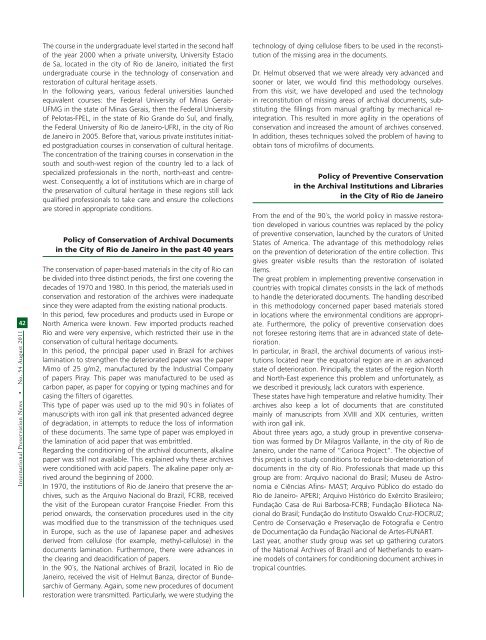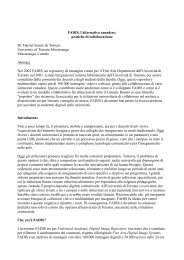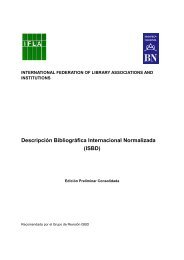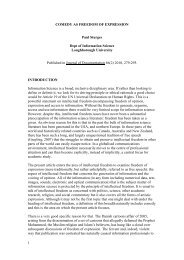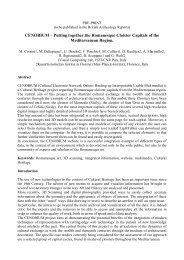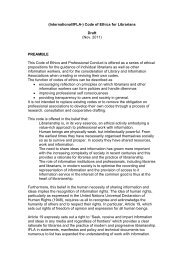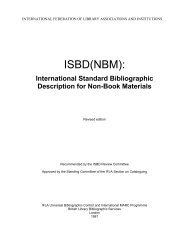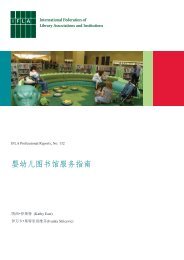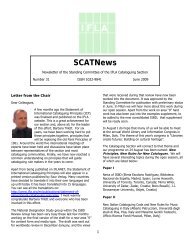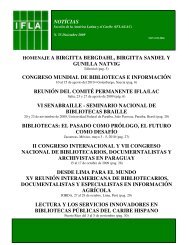N o 54 - IFLA
N o 54 - IFLA
N o 54 - IFLA
You also want an ePaper? Increase the reach of your titles
YUMPU automatically turns print PDFs into web optimized ePapers that Google loves.
42<br />
International Preservation News • No. <strong>54</strong> August 2011<br />
The course in the undergraduate level started in the second half<br />
of the year 2000 when a private university, University Estacio<br />
de Sa, located in the city of Rio de Janeiro, initiated the first<br />
undergraduate course in the technology of conservation and<br />
restoration of cultural heritage assets.<br />
In the following years, various federal universities launched<br />
equivalent courses: the Federal University of Minas Gerais-<br />
UFMG in the state of Minas Gerais, then the Federal University<br />
of Pelotas-FPEL, in the state of Rio Grande do Sul, and finally,<br />
the Federal University of Rio de Janeiro-UFRJ, in the city of Rio<br />
de Janeiro in 2005. Before that, various private institutes initiated<br />
postgraduation courses in conservation of cultural heritage.<br />
The concentration of the training courses in conservation in the<br />
south and south-west region of the country led to a lack of<br />
specialized professionals in the north, north-east and centrewest.<br />
Consequently, a lot of institutions which are in charge of<br />
the preservation of cultural heritage in these regions still lack<br />
qualified professionals to take care and ensure the collections<br />
are stored in appropriate conditions.<br />
Policy of Conservation of Archival Documents<br />
in the City of Rio de Janeiro in the past 40 years<br />
The conservation of paper-based materials in the city of Rio can<br />
be divided into three distinct periods, the first one covering the<br />
decades of 1970 and 1980. In this period, the materials used in<br />
conservation and restoration of the archives were inadequate<br />
since they were adapted from the existing national products.<br />
In this period, few procedures and products used in Europe or<br />
North America were known. Few imported products reached<br />
Rio and were very expensive, which restricted their use in the<br />
conservation of cultural heritage documents.<br />
In this period, the principal paper used in Brazil for archives<br />
lamination to strengthen the deteriorated paper was the paper<br />
Mimo of 25 g/m2, manufactured by the Industrial Company<br />
of papers Piray. This paper was manufactured to be used as<br />
carbon paper, as paper for copying or typing machines and for<br />
casing the filters of cigarettes.<br />
This type of paper was used up to the mid 90´s in foliates of<br />
manuscripts with iron gall ink that presented advanced degree<br />
of degradation, in attempts to reduce the loss of information<br />
of these documents. The same type of paper was employed in<br />
the lamination of acid paper that was embrittled.<br />
Regarding the conditioning of the archival documents, alkaline<br />
paper was still not available. This explained why these archives<br />
were conditioned with acid papers. The alkaline paper only arrived<br />
around the beginning of 2000.<br />
In 1970, the institutions of Rio de Janeiro that preserve the archives,<br />
such as the Arquivo Nacional do Brazil, FCRB, received<br />
the visit of the European curator Françoise Friedler. From this<br />
period onwards, the conservation procedures used in the city<br />
was modified due to the transmission of the techniques used<br />
in Europe, such as the use of Japanese paper and adhesives<br />
derived from cellulose (for example, methyl-cellulose) in the<br />
documents lamination. Furthermore, there were advances in<br />
the clearing and deacidification of papers.<br />
In the 90´s, the National archives of Brazil, located in Rio de<br />
Janeiro, received the visit of Helmut Banza, director of Bundesarchiv<br />
of Germany. Again, some new procedures of document<br />
restoration were transmitted. Particularly, we were studying the<br />
technology of dying cellulose fibers to be used in the reconstitution<br />
of the missing area in the documents.<br />
Dr. Helmut observed that we were already very advanced and<br />
sooner or later, we would find this methodology ourselves.<br />
From this visit, we have developed and used the technology<br />
in reconstitution of missing areas of archival documents, substituting<br />
the fillings from manual grafting by mechanical reintegration.<br />
This resulted in more agility in the operations of<br />
conservation and increased the amount of archives conserved.<br />
In addition, theses techniques solved the problem of having to<br />
obtain tons of microfilms of documents.<br />
Policy of Preventive Conservation<br />
in the Archival Institutions and Libraries<br />
in the City of Rio de Janeiro<br />
From the end of the 90´s, the world policy in massive restoration<br />
developed in various countries was replaced by the policy<br />
of preventive conservation, launched by the curators of United<br />
States of America. The advantage of this methodology relies<br />
on the prevention of deterioration of the entire collection. This<br />
gives greater visible results than the restoration of isolated<br />
items.<br />
The great problem in implementing preventive conservation in<br />
countries with tropical climates consists in the lack of methods<br />
to handle the deteriorated documents. The handling described<br />
in this methodology concerned paper based materials stored<br />
in locations where the environmental conditions are appropriate.<br />
Furthermore, the policy of preventive conservation does<br />
not foresee restoring items that are in advanced state of deterioration.<br />
In particular, in Brazil, the archival documents of various institutions<br />
located near the equatorial region are in an advanced<br />
state of deterioration. Principally, the states of the region North<br />
and North-East experience this problem and unfortunately, as<br />
we described it previously, lack curators with experience.<br />
These states have high temperature and relative humidity. Their<br />
archives also keep a lot of documents that are constituted<br />
mainly of manuscripts from XVIII and XIX centuries, written<br />
with iron gall ink.<br />
About three years ago, a study group in preventive conservation<br />
was formed by Dr Milagros Vaillante, in the city of Rio de<br />
Janeiro, under the name of “Carioca Project”. The objective of<br />
this project is to study conditions to reduce bio-deterioration of<br />
documents in the city of Rio. Professionals that made up this<br />
group are from: Arquivo nacional do Brasil; Museu de Astronomia<br />
e Ciências Afins- MAST; Arquivo Público do estado do<br />
Rio de Janeiro- APERJ; Arquivo Histórico do Exército Brasileiro;<br />
Fundação Casa de Rui Barbosa-FCRB; Fundação Bilioteca Nacional<br />
do Brasil; Fundação do Instituto Oswaldo Cruz-FIOCRUZ;<br />
Centro de Conservação e Preservação de Fotografia e Centro<br />
de Documentação da Fundação Nacional de Artes-FUNART.<br />
Last year, another study group was set up gathering curators<br />
of the National Archives of Brazil and of Netherlands to examine<br />
models of containers for conditioning document archives in<br />
tropical countries.


